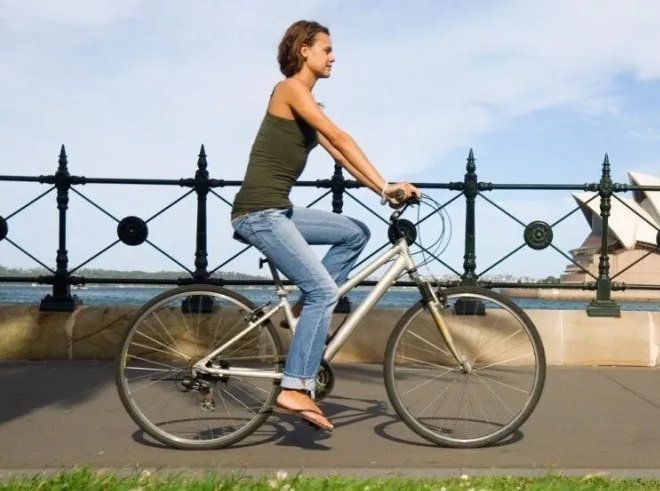Late last year, Streetsblog covered the stunning news that the National Transportation Safety Board had recommended state-by-state mandatory helmet laws — a practice that has been shown to reduce cycling and make cyclists less safe overall. The decision by the panel of political appointees over-ruled the NTSB staff's own recommendation against helmet laws. Outrage has followed that political move, with the latest opposition offered by the Association of Pedestrian and Bicycle Professionals in a letter this week to the NTSB. We publish it in full:
We thank NTSB for taking on bicycling safety at a time when fatalities are on the rise and support your recommendations on building better infrastructure and improving vehicle design to enhance conspicuity. However, we are writing today to express our grave concern with your recommendation on mandatory helmet laws and would like to request the opportunity to discuss the issue in person.
The Association of Pedestrian and Bicycle Professionals is a community of practitioners working to create more walkable, bikeable places. We foster peer knowledge sharing, advance technical expertise, and support the professional development of our members. As professionals in the field, we agree that improving the safety of people walking and biking is paramount. However, we believe mandatory helmet laws have the potential to not only reduce the number of people biking, but to actually make bicycling less safe rather than more safe.
In the hearing on Nov. 5, NTSB staff stated that advocates didn’t agree with helmet laws because they could decrease the number of people bicycling. That is only half the story. Multiple studies across North America, Europe and Australia have shown that bicycling safety differs from other modes in one specific way. There is a safety in numbers effect to bicycling that not only reduces the rate of crashes and fatalities for people biking, but actually reduces the number of crashes, even as the number of bicycling trips increase.
More people bicycling reduces the rate of bicycling fatalities
Conventional wisdom tells us that traffic fatalities increase with the number of miles traveled. While that proves to be true for motor vehicles, that is not true for bicycling and walking. A 2003 report, studying five different data sets across European countries and American cities found, “The likelihood that a given person walking or bicycling will be struck by a motorist varies inversely with the amount of walking or bicycling. This pattern is consistent across communities of varying size, from specific intersections to cities and countries, and across time periods.”
The more people bike in a country generally the safer it is for cycling. This phenomenon is called "safety in numbers." Graph: International Transport Forum via Amsterdamize (FOOTNOTE 2)
Reduction of crashes and fatalities as bicycling increases
In U.S. cities, the increase in bicycling trips has not only led to a reduction in crash and fatality rates, but even as the number of miles bicycled increased, actual numbers of crashes and fatalities have decreased. A 2008 study in New York City found that in 1998, the city had an average daily ridership of 80,000 people and over 9,000 bicycle crashes and fatalities combined. In 2008, the city had an average daily ridership of 180,000 bicyclists, but had less than 3,000 bicycle crashes and fatalities.
The same trend has been found in Minneapolis, Boulder, California cities, and in cities that have introduced bikeshare.
Bikeshare, increased bicycling and the effect on head injuries
In this study of bicycle injuries and head injuries, the authors went into the study with the assumption that bikeshare would reduce helmet use, and therefore increase head injuries.
The actual results compared bicycle crash injuries and head injuries in bike share cities versuscontrol cities and found that in cities that adopted bikeshare systems:
Bicycle trips increased at a faster rate
Crashes decreased at a faster rate
Crashes with head injuries decreased at a faster rate
Crashes with severe head injuries decreased at a faster rate
There were no fatalities in the bikeshare cities during these three years. In fact, there were no bikeshare fatalities in the U.S. for the first seven years of it being introduced in the country.
The effect of mandatory helmet laws on head injury rates among bicyclists, and on bicycling rates
While an individual choosing to wear a bicycle helmet can increase safety for that individual, the societal effect of mandatory helmet laws can be expected to reduce safety overall. A 2006 study of head injuries of bicyclists in jurisdictions after enforcement of helmet laws showed no noticeable drop in head injuries, but did show drops in bicycling of between 20 and 44 percent.
The study, published in the British Medical Journal, studied cities in Australia, Canada and New Zealand.
The effect of bicycle helmet laws reducing bicycling rates not only makes bicycling less safe; it has long-term impact on the health of those communities. Bikeshare has been a boon to bicycling in cities across this country and the world. However, in cities with mandatory bicycle helmet laws such as Brisbane and Melbourne, Australia and Seattle, Washington, bikeshare systems struggle to gain traction.
A 2012 paper in the journal Risk Analysis weighed the reduction of head injuries due to mandatory helmet laws against the increased morbidity due to foregone exercise from reduced cycling. The study concluded that mandatory helmet laws “have a net negative health impact.”
Discriminatory enforcement of mandatory bike helmet laws
Mandatory helmet laws for minors are relatively common across the U.S., which demonstrates a serious concern for inequitable enforcement. While not intentional, the consequences of mandatory bike helmet laws are likely to cause serious concern for minority and low-income populations. Here are just a few examples: After bike helmets were made mandatory in Austin, Texas, 92 percent of tickets were issued to African-American and Latino children. Tampa, Fla. was in the news where police were potentially violating civil rights laws while enforcing bicycling laws, including helmet laws.
Discriminatory practices that target low income and people of color communities further discourage bicycling, including in low income communities where bicycling can often be a low-cost transportation option in areas where transit isn’t readily available or easily accessible.
Conclusion
As an association of practitioners in a field that promotes and encourages safe bicycling, APBP wants to stress the importance of increasing the number of people of bicycling to ensuring bicycling is safe. Bike helmet laws are not the same as mandatory seat belt or motorcycle helmet laws. In contrast to these laws, there is clear evidence that the more people bicycling in a community, the safer bicycling becomes for everyone, and there is evidence that mandatory helmet laws can reduce bicycling rates, effecting the “safety in numbers’ argument.
Mandatory helmet laws also make it harder for bikeshare, a service that increases bicycling rates and thus bicycling safety, to be successful.
Jessica Roberts (@jessicaroberts) is president of the Association of Pedestrian and Bicycle Professionals. Caron Whitaker (@caronwhitaker) is a policy specialist for the group. Follow the group on Twitter at @apbp.






